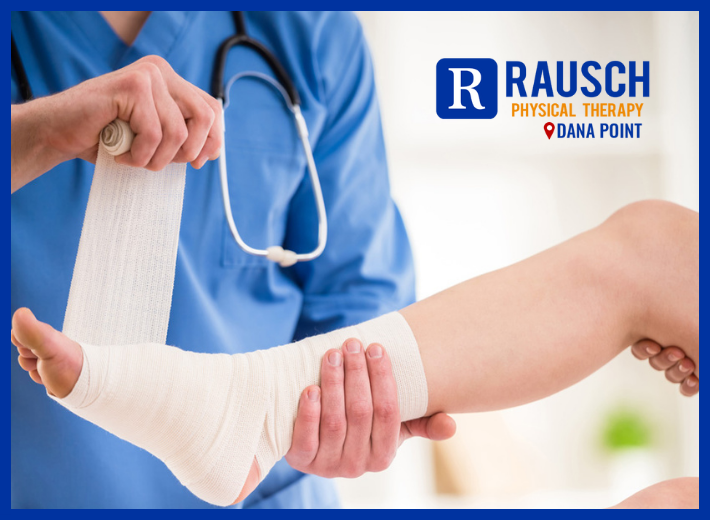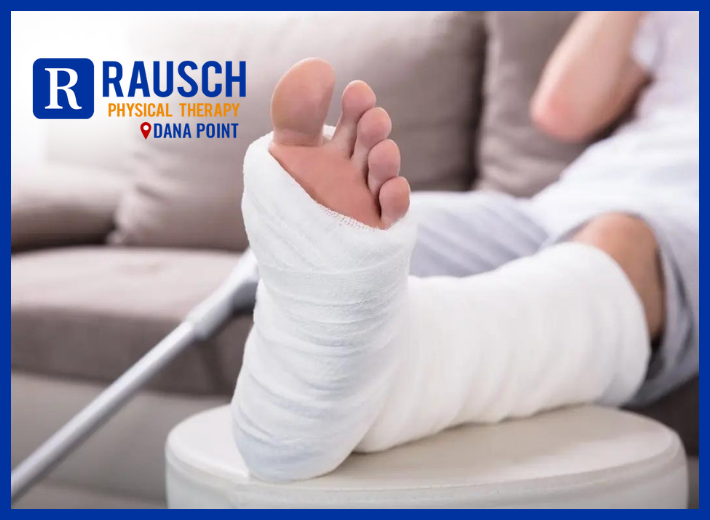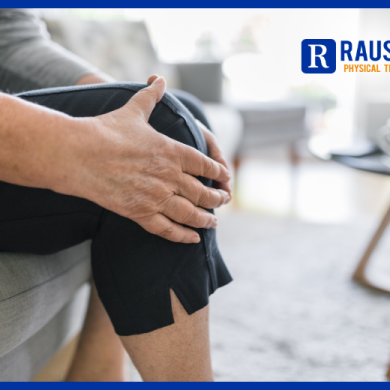Carpal tunnel syndrome is a condition that can cause pain, numbness, and tingling in the hand and wrist. It occurs when the median nerve, which runs through a narrow passage,
How PT Can Help You Heal Your Broken Foot
June 1, 2023 3:41 pm / Category: Rausch Physical Therapy

A broken foot can be a painful and frustrating experience, but with the right care and support, you can recover fully. At Rausch PT, we understand the challenges that come with foot injuries, and we’re here to help you get back on your feet. Learn the causes and symptoms of a broken foot, and how PT can aid in the recovery process.
A broken foot is an injury to the bone. You may experience a broken foot during a car crash or from a simple misstep or fall.
The seriousness of a broken foot varies. Fractures can range from tiny cracks in your bones to breaks that pierce your skin.
Treatment for a broken foot depends on the exact site and severity of the fracture. A severely broken foot may require surgery to implant plates, rods or screws into the broken bone to maintain proper position during healing.
Symptoms
If you have a broken foot, you may experience some of the following signs and symptoms:
- Immediate, throbbing pain
- Pain that increases with activity and decreases with rest
- Swelling
- Bruising
- Tenderness
- Deformity
- Difficulty in walking or bearing weight
When to see a doctor
See a doctor if there is obvious deformity, if the pain and swelling don’t get better with self-care, or if the pain and swelling gets worse over time. Also, see a doctor if the injury interferes with walking.
Causes
The most common causes of a broken foot include:
- Car accidents. The crushing injuries common in car accidents may cause breaks that require surgical repair.
- Falls. Tripping and falling can break bones in your feet, as can landing on your feet after jumping down from just a slight height.
- Impact from a heavy weight. Dropping something heavy on your foot is a common cause of fractures.
- Missteps. Sometimes just putting your foot down wrong can result in a broken bone. A toe can get broken from stubbing your toes on furniture.
- Overuse. Stress fractures are common in the weight-bearing bones of your feet. These tiny cracks are usually caused over time by repetitive force or overuse, such as running long distances. But they can also occur with normal use of a bone that’s been weakened by a condition such as osteoporosis.
Risk factors
You may be at higher risk of a broken foot or ankle if you:
- Participate in high-impact sports. The stresses, direct blows and twisting injuries that occur in sports such as basketball, football, gymnastics, tennis and soccer can causes foot fractures.
- Use improper technique or sports equipment. Faulty equipment, such as shoes that are too worn or not properly fitted, can contribute to stress fractures and falls. Improper training techniques, such as not warming up and stretching, also can cause foot injuries.
- Suddenly increase your activity level. Whether you’re a trained athlete or someone who’s just started exercising, suddenly boosting the frequency or duration of your exercise sessions can increase your risk of a stress fracture.
- Work in certain occupations. Certain work environments, such as a construction site, put you at risk of falling from a height or dropping something heavy on your foot.
- Keep your home cluttered or poorly lit. Walking around in a house with too much clutter or too little light may lead to falls and foot injuries.
- Have certain conditions. Having decreased bone density (osteoporosis) can put you at risk of injuries to your foot bones.
Complications
Complications of a broken foot are uncommon but may include:
- Arthritis. Fractures that extend into a joint can cause arthritis years later. If your foot starts to hurt long after a break, see your doctor for an evaluation.
- Bone infection (osteomyelitis). If you have an open fracture, meaning one end of the bone protrudes through the skin, your bone may be exposed to bacteria that cause infection.
- Nerve or blood vessel damage. Trauma to the foot can injure adjacent nerves and blood vessels, sometimes actually tearing them. Seek immediate attention if you notice any numbness or circulation problems. Lack of blood flow can cause a bone to die and collapse.
Prevention
These basic sports and safety tips may help prevent a broken foot:
- Wear proper shoes. Use hiking shoes on rough terrain. Wear steel-toed boots in your work environment if necessary. Choose appropriate athletic shoes for your sport.
- Replace athletic shoes regularly. Discard sneakers as soon as the tread or heel wears out or if the shoes are wearing unevenly. If you’re a runner, replace your sneakers every 300 to 400 miles.
- Start slowly. That applies to a new fitness program and each individual workout.
- Cross-train. Alternating activities can prevent stress fractures. Rotate running with swimming or biking.
- Build bone strength. Calcium-rich foods, such as milk, yogurt and cheese, really can do your body good. Taking vitamin D supplements also can help.
- Use night lights. Many broken toes are the result of walking in the dark.
- Declutter your house. Keeping clutter off the floor can help you to avoid trips and falls.
Are you suffering from a broken foot? Our expert physical therapists at Rausch PT can help you recover safely and quickly. Contact us today at 949-597-0007 to schedule a consultation with one of our specialists. And don’t forget to follow us on Instagram for more helpful tips and information on how to stay healthy and injury-free.
Reference: [https://www.mayoclinic.org/diseases-conditions/broken-foot/symptoms-causes/syc-20355492]






